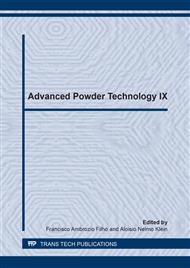p.552
p.558
p.563
p.569
p.574
p.579
p.585
p.590
p.596
Feasibility Study for Feedstock Recycling on PIM Nd-Fe-B Permanent Magnets
Abstract:
Powder injection molding (PIM) is a well-known process for the production of geometrically complex shaped parts at a high production rate. The possibility of recycling the raw material (feedstock) is economically necessary for industrial applications, especially when processing very expensive materials, such as rare-earth alloys. In this study, Nd-Fe-B magnets were fabricated by powder injection molding, in which the injection residues (gates, sprue and surplus green samples) were reprocessed, up to 6 times. Subsequently, samples underwent binder extraction by chemical and thermal procedures, being finally sintered under high vacuum. Physical characterizations were carried out and the magnetic properties were measured via B-H trace analysis in each batch to study the influence of the recycled feedstock on the magnetic properties of produced samples. It was concluded that the properties are significantly affected after the second reprocessing lot, mainly due to the contamination of the feedstock by organic elements by-products of the binder decomposition.
Info:
Periodical:
Pages:
574-578
Citation:
Online since:
December 2014
Price:
Сopyright:
© 2014 Trans Tech Publications Ltd. All Rights Reserved
Share:
Citation:


